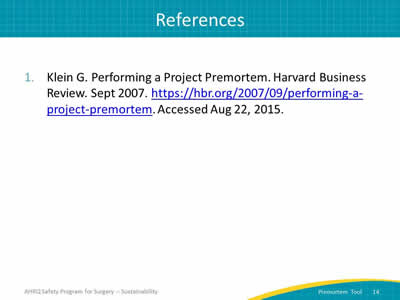Sustainability and the Premortem Tool: Facilitator Notes
AHRQ Safety Program for Surgery
Slide 1: Sustainability and the Premortem Tool
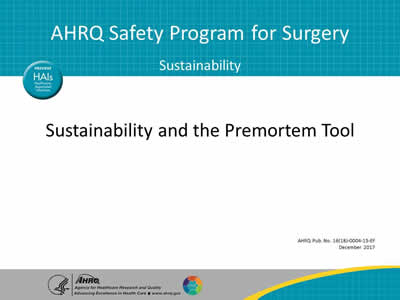
Say:
This module will cover Sustainability and the Premortem Tool.
Projects can fail for many reasons, and the safe surgery project is no exception to this possibility. Understanding barriers that can impede project implementation will help your team plan for the sustainability of your project’s achievements.
Slide 2: Learning Objectives
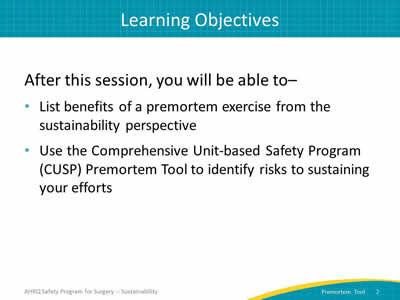
Say:
After this session, you will be able to list the benefits of looking at what could cause a project to fail to sustain. You will also be able to use the Premortem Tool from the Comprehensive Unit-based Safety Program (CUSP).
The premortem tool proactively raises awareness to potential risks, providing teams the opportunity to address those issues.
Slide 3: Problem Statement
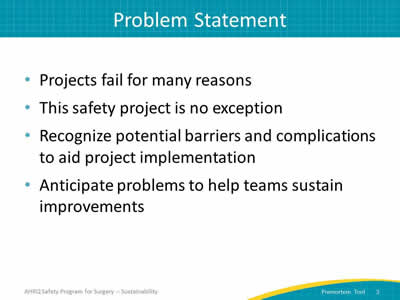
Say:
Projects often fail due to many circumstances. This project is no exception. Understanding potential barriers to and complications of project implementation can help teams prepare to sustain improvements.
This module will walk through ways to identify those barriers. Generally, a premortem is conducted at the beginning of the project. This allows teams to reflect on how the project might fail before it starts and build in practices to prevent failure. In this module, the premortem exercise is framed to anticipate problems or barriers to sustainability.
The premortem is a step toward sustaining the surgical safety initiatives in your unit. The idea is to brainstorm for possible failure points in order to address them.
Slide 4: Preparing To Lead
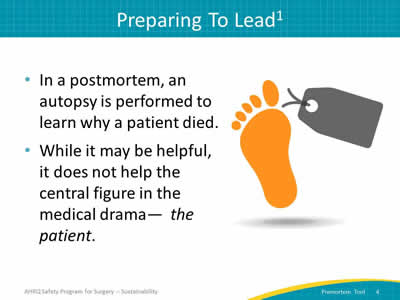
Say:
To better understand the premortem, consider the postmortem process. In the postmortem, the autopsy is performed to find out why the patient died. While that is helpful to the clinicians and those interested in the results, it doesn’t help the patient.
Slide 5: Preparing To Lead
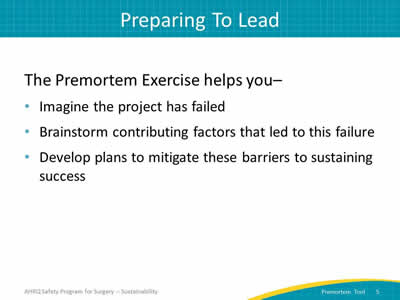
Say:
Similarly, doing a postmortem for a project after it ends doesn’t help the functioning project. A premortem encourages you to imagine that the project has failed and brainstorm the reasons that could lead to this failure. After barriers to success are identified, develop plans to mitigate the barriers.
Work on this exercise as a team. If you complete the exercise individually, have team members share their responses with the team.
Slide 6: Preparing To Lead
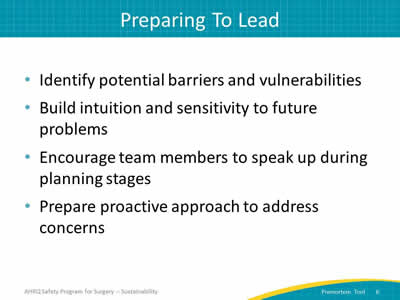
Say:
The premortem exercise is used to identify potential barriers and vulnerabilities to long-term safe surgery project successes. The successful use of this tool helps to build team intuition for and sensitivity to future problems.
Projects fail when key stakeholders fail to speak up about their reservations during the planning stages. The premortem for sustainability focuses the safety team’s attention on the longevity of their intervention efforts. It allows the team to prepare a proactive approach to address those concerns.
There are four steps to completing the premortem exercise. The next few slides will review these four steps.
Slide 7: Premortem Exercise
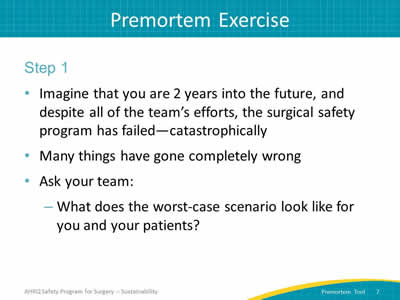
Say:
The first step is to imagine that you’re 2 years into the future, and despite all of your best efforts, the safe surgery project has failed.
Ask:
What might have gone wrong?
Say:
Let’s assume patient care hasn’t improved. Perhaps your team is not engaged. Maybe no one was available to gather data. Maybe no one has heard of your safe surgery effort.
In this first step, ask yourself what the worst-case scenario might look like.
Slide 8: Premortem Exercise
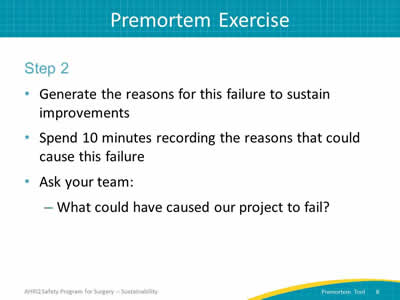
Say:
In step two, consider the reasons that caused your project to fail. Do this as a team. Brainstorm and document all of these reasons. Ask each team member what she or he thinks could go wrong.
Ask:
Was staff overburdened?
Were there too many competing priorities?
What could have caused our project to fail?
Slide 9: Premortem Exercise
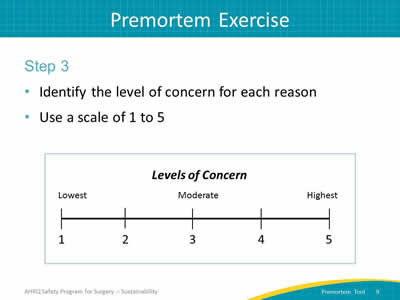
Say:
In step three, identify the concerns that would be raised by each identified potential cause for failure.
Ask:
Is one more likely to derail your effort than another?
Say:
Which failures would impede sustainability of the safe surgery project? Use the scale shown here to rank your team’s concerns about each failure.
Slide 10: Premortem Exercise
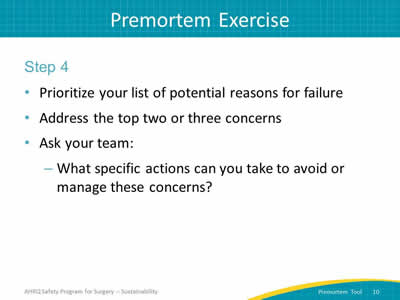
Say:
In step four, prioritize the list of reasons why your safe surgery project could fail. Consider the concerns that you identified for each reason. Focus on the top two or three concerns that your group identified.
Ask:
What can your team implement to avoid or mitigate these failure points?
Slide 11: CUSP Premortem Summary
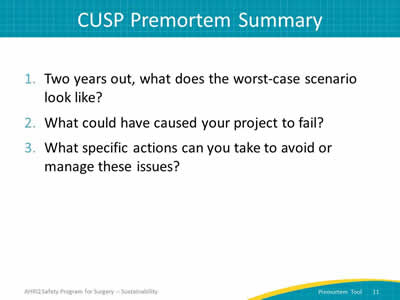
Say:
Here’s a summary of the steps in the premortem exercise:
- Two years after your safe surgery project has started, what would the worst-case scenario for your efforts look like?
- What could have caused your project to fail?
- What specific actions can you take to avoid or manage these issues?
- Review and anticipate potential problems throughout the project.
Conduct this premortem exercise with your team and share your insights at a followup meeting.
Slide 12: Discussion
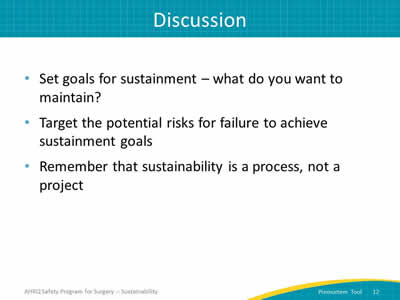
Say:
When strategizing for sustainability:
Set goals for your sustainment.
Ask:
What elements of your safe surgery project do you want to maintain?
Say:
Target potential risks for failure in order to achieve success in sustainment.
Remember that sustainment is more than a project; it is a process. Embed your sustainability plan into your system, and revisit as you move forward.
Slide 13: Discussion Questions
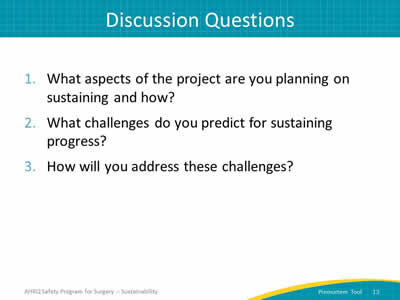
Say:
Discuss these questions with your team. The resulting conversation will help you plan for sustainability of your safe surgery project.
Ask:
- What aspects of the project are you planning to sustain and how?
- What challenges do you predict for sustaining progress?
- How will you address these challenges?
Slide 14: References
